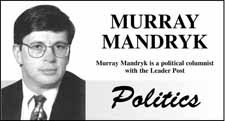After years of feasting off problems of past NDP governments in health care, could it be that Premier Brad Wall is now starting to feel the same frustration?
The still-relatively young Saskatchewan Party government has had a surprisingly easy ride when it comes to health care delivery. Yes, there has been the occasional dust like the problems at the Wakaw Hospital or the decision by the Sun Country Health District to cut beds in Wawota. Most recently, Shellbrook is experiencing a similar doctor/hospital emergency service issue. And horror stories are starting to emerge out of the big city emergency rooms in both Saskatoon and Regina as a result of unprecedented overcrowding.
But at least until recently, the upswing in oil, gas and potash revenue in Saskatchewan has simply allowed the government to throw money at most any problem. Nurses claim to be overworked and underpaid? Well, while the Roy Romanow NDP government had to lay off nurses in the early 1990s and legislate them back to work in the spring of 1999, the Sask. Party government was able to hire more nurses and give them 35-per-cent-plus raises in the spring of 2008.
And while one might question the NDP government's priorities in 1993 that led to closure of 52 rural hospitals and the Plains Health Centre on the outskirts of Regina, no one can questions that it was the massive deficits run up by the previous Grant Devine Progressive Conservative governments of the 1980s that forced decisions to be made.
Fourteen straight balanced NDP government budgets (at least, on the general revenue side) meant that the arriving Sask. Party government were faced with no such dilemma. In fact, the Sask. Party is even building 13 more hospitals and nursing homes in rural Saskatchewan and plans are now in the works to build hospital replacement facilities in North Battleford, Moose Jaw and the new Children's Hospital in Saskatoon.
Of course, it hasn't just been good luck. Credit the Wall government for at least making some of its own good fortune.
The government is on track to spend $4.46 billion on health care this year, which would not only represent the rarity of the health department coming in on budget but will also represent a decrease in health spending not seen since the Romanow government cuts in 1993.
Some of this has to simply do with a less capital construction spending this year, but a lot of it has to do with being smarter and less philosophically tied to how the health care system is suppose to operate.
By viewing hospital patients as customers and by introducing what is called the LEAN efficiency program, cost-savings are being found. And more to the point, surgical waiting lists are going down with the advent of private surgical clinics paid for by the public system - something that wasn't considered by past NDP governments.
But for all the economic advantages the Wall government has enjoyed and for all the wise moves it's made to improve health care delivery, it now seems to be facing the inevitability that all governments face. Sooner or later, the crushing demand of the health system, weigh a government down.
Some of that weight is coming from Ottawa, which has served notice that federal health transfers (now increasing six per cent each year) will be limited to the rate of economic growth.
Much of this weight is the natural - an aging population, a large First Nations population with high demands, on-ongoing demands for premium service in all corners of the province and overall population growth.
But like all governments before them, the Sask. Party may finally be realizing how difficult it is to feed the insatiable appetite of the health system.
Murray Mandryk has been covering provincial politics for over 15 years.




